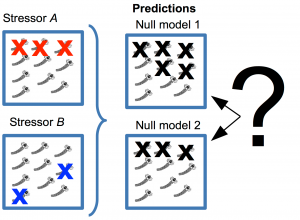In this post, Ralf Schäfer reports on their recently published paper “Advancing understanding and prediction in multiple stressor research through a mechanistic basis for null models”.
In the Anthropocene, ecosystems are commonly exposed to multiple stressors such as habitat degradation, invasion by more competitive non-native species and pollutants. For example, in German rivers the co-occurrence of stressors is rather the norm than an exception as discussed in a previous blogpost. Many studies have examined potential interactions among stressors regarding their effects in marine, freshwater and terrestrial ecosystems. These studies typically compared the observed joint effect from an experiment or, to a lesser extent, from a field monitoring to an expected joint effect, which was predicted with a so-called null model. If the effect was higher and lower than that predicted with a null model, the effect was termed synergistic and antagonistic, respectively. However, synergism and antagonism primarily tell us that we were not able to adequately predict the effect.
In our paper we argue that past research efforts were too much focused on detecting synergism and antagonism. The focus should shift to explaining synergism and this requires reflection on how stressors interact, e.g. information on mechanisms such as how the stressor affects organisms and the relationship between stressor intensity and effect. Often the null models to predict the joint effects were not selected based on mechanistic reflection but rather through the choice of a statistical model, an issue that many authors were unaware of. In our paper, we introduce a conceptual model on how stressors may interact, identify elements of mechanistic understanding of joint effects and provide additional null models for multiple stressor research that are widely used in ecotoxicology but have to date been ignored in multiple stressor research. Moreover, we present tentative guidelines on how to select the null model predicting the joint effects of multiple stressors. Finally, we suggest that the prediction of multiple stressor effects is most suitable on the level of individuals and populations, whereas for prediction of the effects on communities, food webs or ecosystem function, the null models need to be integrated with other ecological models.
The paper was authored by Ralf B. Schäfer and Jeremy J. Piggott and published in Global Change Biology.
If you want to know more about the topic, you can also watch a talk given at the FRAM Centre for Future Chemical Risk Assessment and Management Strategies of University of Gothenburg:
LIVESTREAM: How to measure multiple environmental stressors – FRAM-seminar with Professor Ralf B Schäfer
Posted by FRAM Centre at University of Gothenburg on Dienstag, 30. Januar 2018

